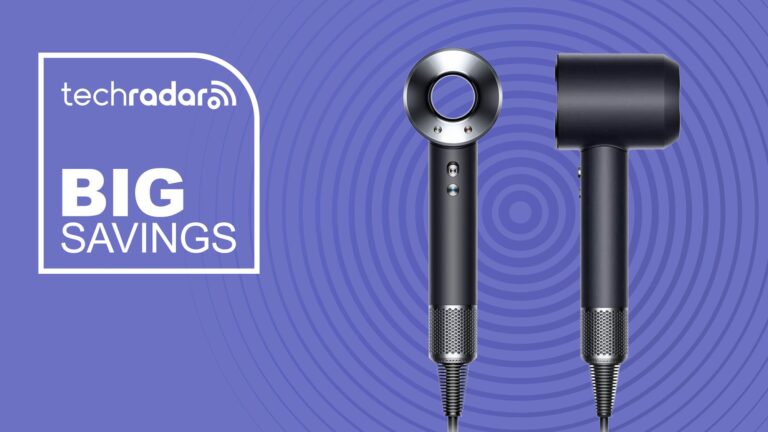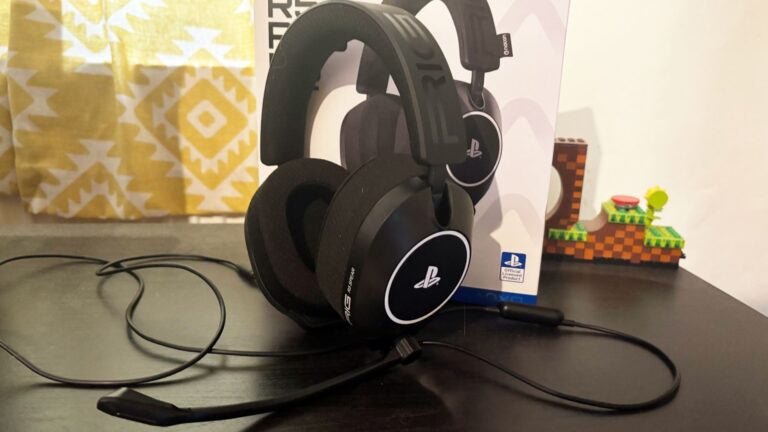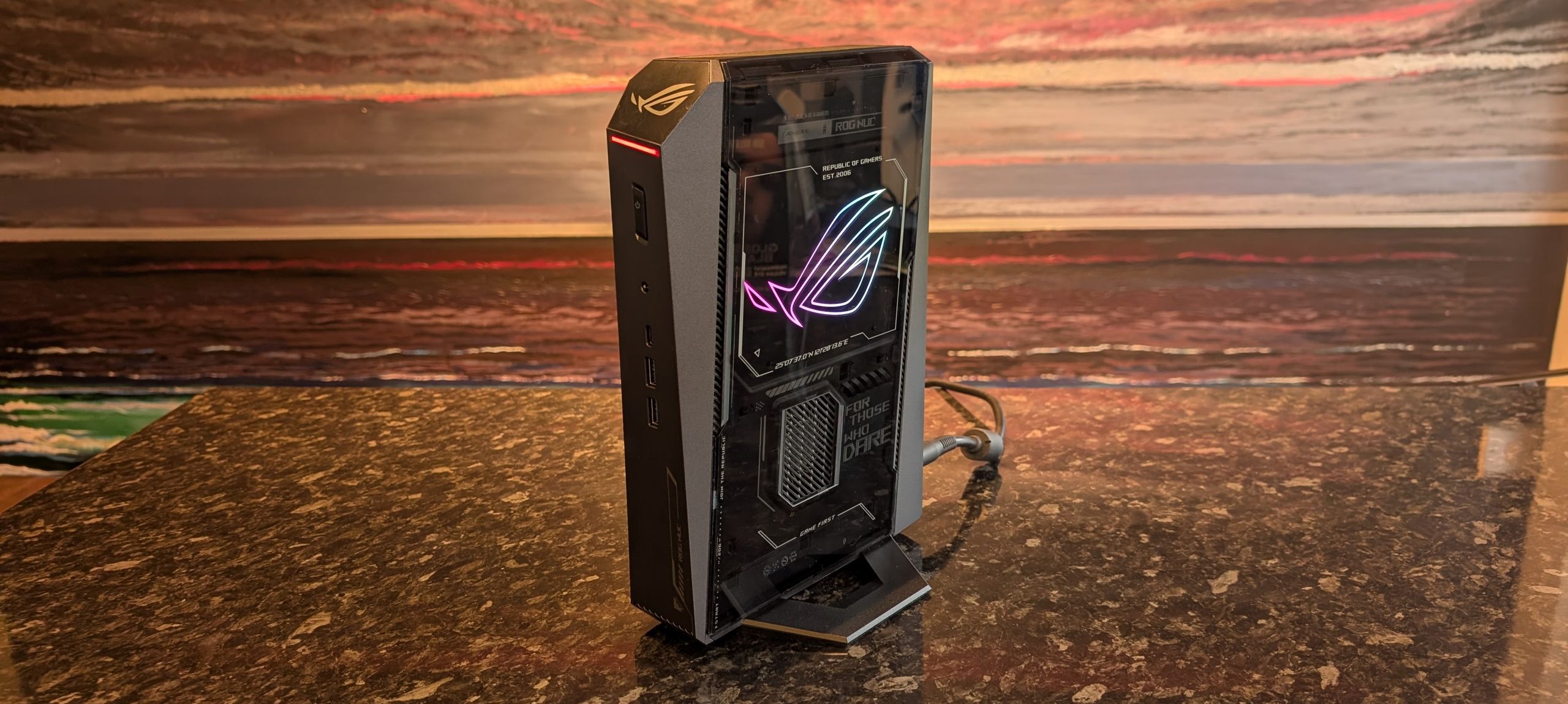
Why you can trust TechRadar
We spend hours testing every product or service we review, so you can be sure you’re buying the best. Find out more about how we test.
Asus ROG NUC (2025): Two-minute review
I’ll start this review off by simply saying this: the Asus ROG NUC absolutely belongs on our list of the best mini PCs, and perhaps indeed the best computers overall – expect to see it make an appearance on those pages in the near future.
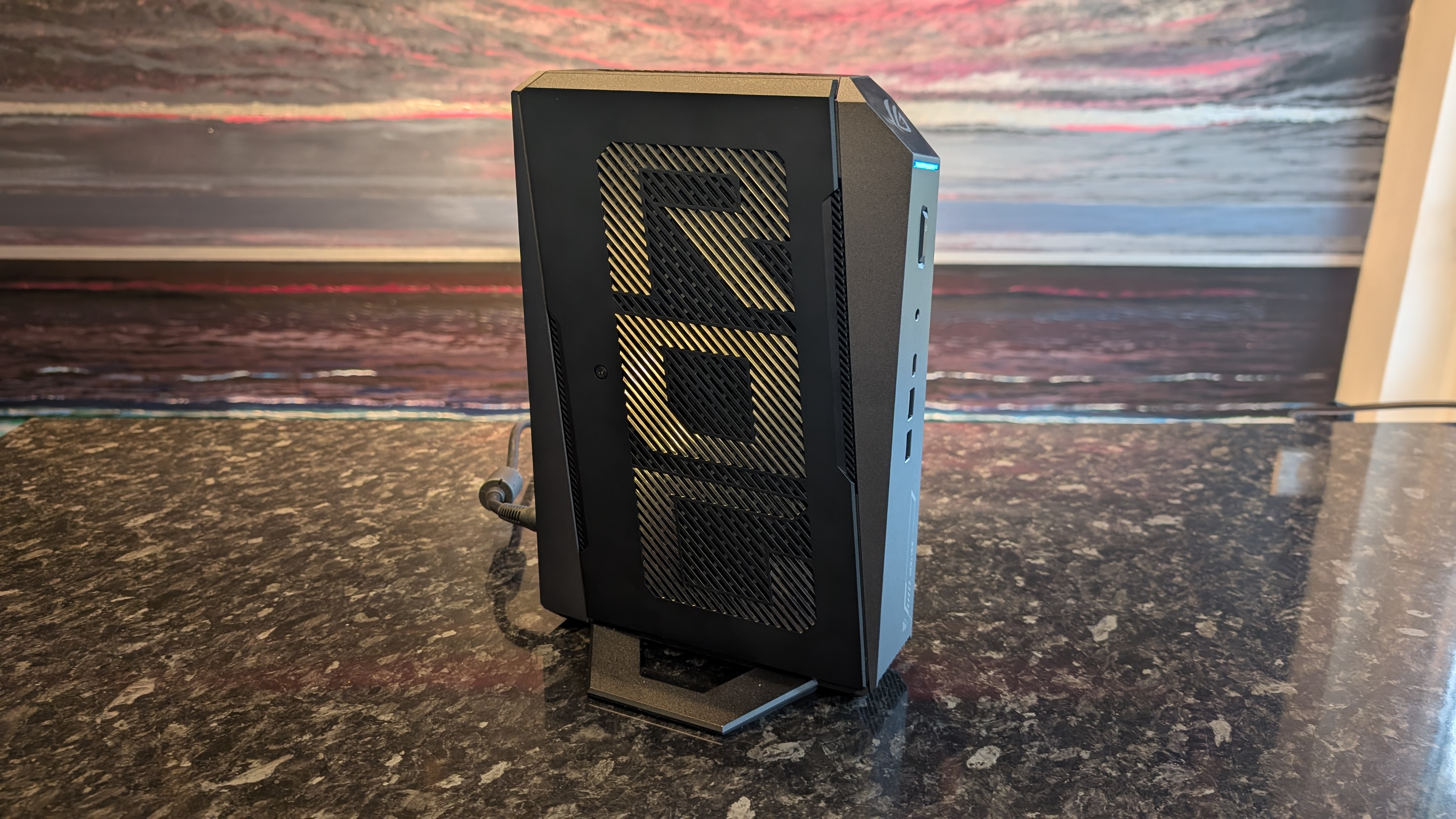
The whole system is essentially constructed around that graphics card, which is technically a laptop GPU – one can only assume that a full-scale desktop 5080 would be too chunky, even though Nvidia worked hard to scale down the comically gigantic cards of the RTX 3000 and 4000 eras. As you might expect, performance is excellent; expect high framerates and smooth gameplay at 1440p and even 4K, though the sorry state of modern PC game optimization means you’ll probably need to turn on DLSS in some titles at 4K.
Those powerful components mean the ROG NUC is also a competent workstation system, which could prove to be a boon for professional creatives who need a powerful PC but have limited desk real estate to work with (and don’t want to jump ship to macOS with the admittedly excellent M4 Mac mini).
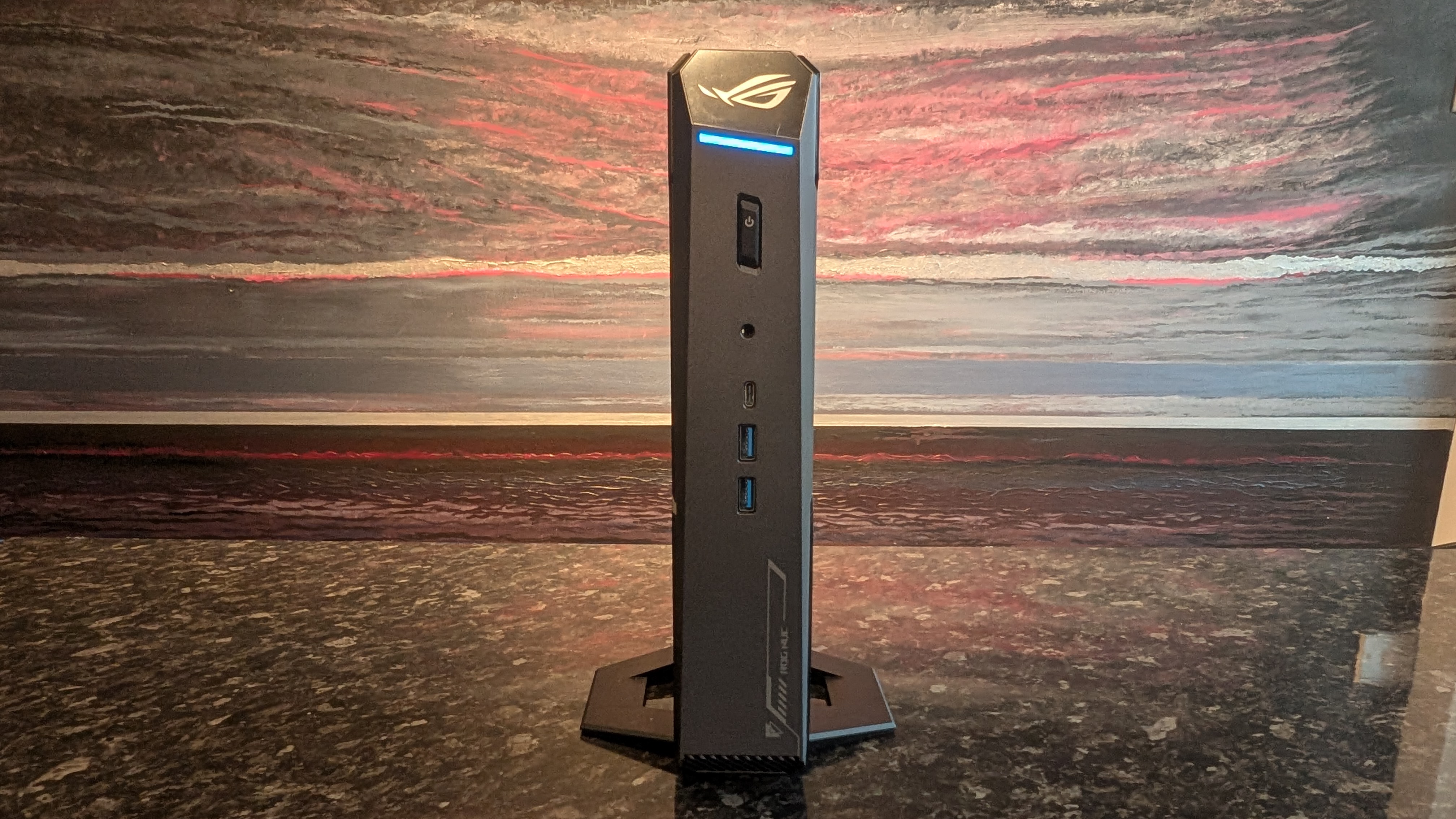
Of course, a spec sheet like that does mean that the Asus ROG NUC is far from cheap. I’ll get into the details in the pricing section below, but my review unit will set you back $3,199 / £2,599 (around AU$4,925) – no small sum for anybody, and a lot more than Apple’s signature mini computer will cost you. Of course, any pre-built RTX 5080 desktop from a reputable manufacturer is going to cost you at least somewhere in the range of $2,800 / £2,000 / AU$5,000, so it’s not an entirely ludicrous proposition even if it does place the ROG NUC beyond the budgets of many PC gamers.
Despite this, I loved using the new Asus ROG NUC, and having tested NUC devices in the past, I can comfortably say that it’s one of the best iterations on the formula yet. If you’ve got the money to spend and want something that delivers a lot of power in a small package, this device is the way to go.
Asus ROG NUC (2025) review: Price & Availability
- Starts from $2,599 / £2,129 (about AU$4,000)
- Available now in the US and UK
- Both RTX 5070 Ti and 5080 models available
Starting at $2,599 / £2,129 (about AU$4,000) for the base configuration, which sports an RTX 5070 Ti rather than the 5080 in my review unit, along with less storage and RAM as you can see in the spec table below, the new ROG NUC isn’t exactly what I’d call affordable. Meanwhile, the 5080 model featured in this review – which is externally identical – will run you a hefty $3,199 / £2,599 (around $4,925).
Still, it’s not absurdly priced for what it offers; considering the sheer lack of powerful compact PCs on the market, the best option for many potential users will be to build your own ITX system, and having spent plenty of time mucking about with compact PC cases in my years as a computer hardware journalist, I can say with certainty that it’ll be a lot harder than simply buying a ROG NUC. Oh, and it most likely won’t be as small, and will potentially end up being more expensive too!
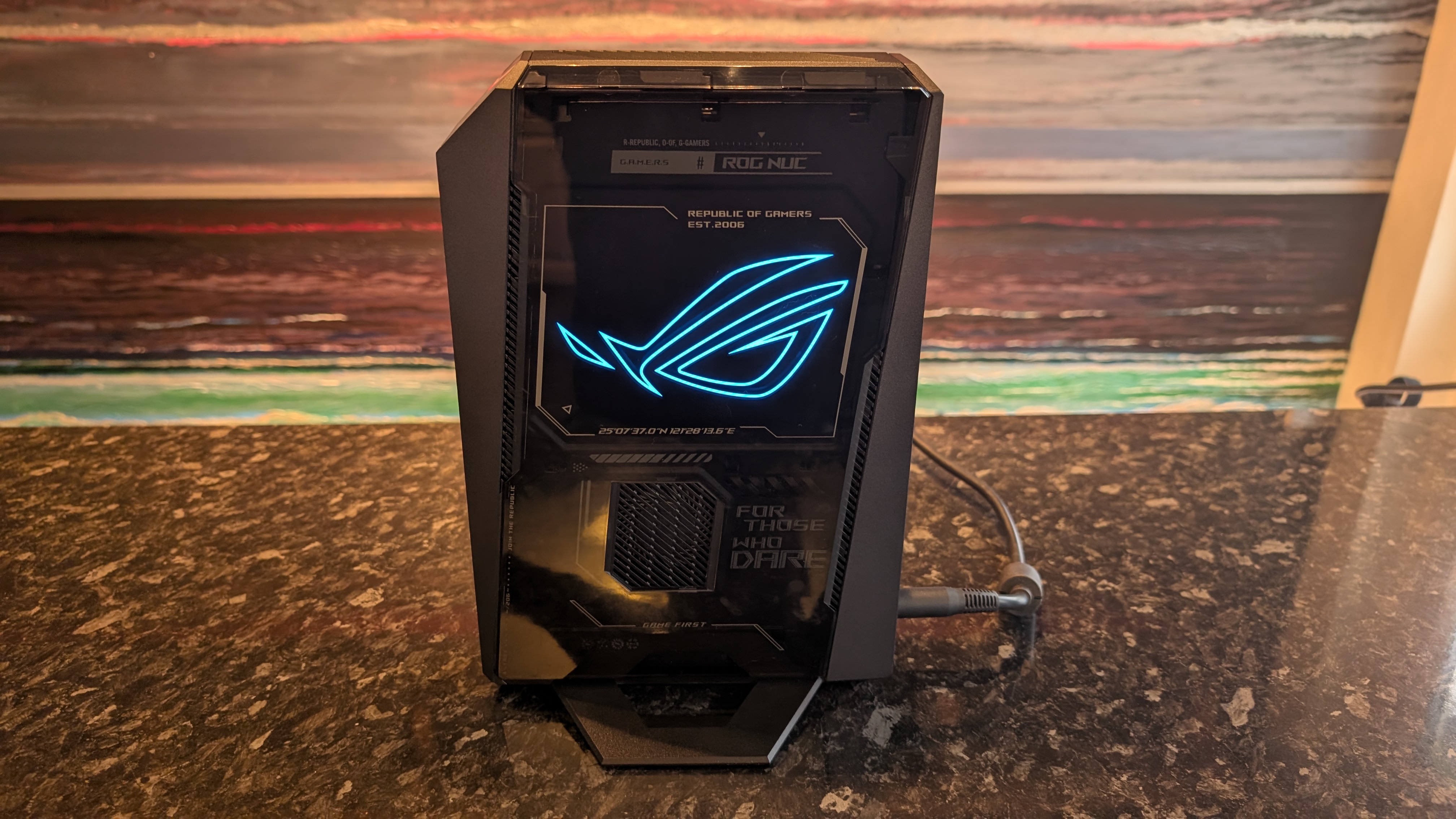
So while the NUC is undeniably a pretty expensive piece of kit, I can’t mark it down too much for that; if a powerful but ultra-compact PC for serious gaming or content creation work is what you want, this might be the single best option out there right now. Of course, a PS5 Pro will cost you a lot less… but it also doesn’t fill the role of a fully capable desktop PC.
The Asus ROG NUC (2025) is already available to purchase direct from Asus and partner retailers in the US and UK, but it seems our Aussie friends will have to wait a little longer – though Asus did confirm that the new model will indeed be coming to Australia. Regional pricing for Australia is currently unconfirmed (the figures listed above are only conversions).
Asus ROG NUC (2025) review: Specs
| Row 0 – Cell 0 | Asus ROG NUC (2025) Base Config | Asus ROG NUC (2025) Review Config |
Price | $2,599 / £2,129 (about AU$4,000) | $3,199 / £2,599 (around AU$4,925) |
CPU | Intel Core i5-13420H (8 cores, 2.10GHz) | Intel Core Ultra 9 275HX (2.70GHz) |
GPU | Nvidia GeForce RTX 5070 Ti 16GB Laptop GPU | Nvidia GeForce RTX 5080 16GB Laptop GPU |
RAM | 16GB DDR5 | 32GB DDR5 |
Storage | 1TB PCIe NVMe 4.0 M.2 SSD | 2TB PCIe NVMe 4.0 M.2 SSD |
Ports and Connectivity | 6x USB-A 3.2 Gen 1, 2x USB-C 3.2 Gen 2 (Thunderbolt 4), 2x HDMI 2.1, 2x DisplayPort 2.1, 1x RJ-45, 1x 3.5mm combi audio jack, Kensington Lock | 6x USB-A 3.2 Gen 1, 2x USB-C 3.2 Gen 2 (Thunderbolt 4), 2x HDMI 2.1, 2x DisplayPort 2.1, 1x RJ-45, 1x 3.5mm combi audio jack, Kensington Lock |
Dimensions | 11.1 x 7.4 x 2.2in / 28.2cm x 18.8cm x 5.7cm | 11.1 x 7.4 x 2.2in / 28.2cm x 18.8cm x 5.7cm |
Weight | 6.79lbs / 3.12kg | 6.79lbs / 3.12kg |
Asus ROG NUC (2025) review: Design
- Amazingly compact design
- Surprisingly good amount of ports
- Limited upgrade potential for a desktop PC
Making a compact PC chassis can take designers in a lot of different directions. Do you aim for a low, flat design like Apple’s Mac mini, or build upwards with a small footprint like the fantastic Corsair One i500?
As you can no doubt tell from the pictures, Asus has gone for the latter approach, with a thin tower design that produces a footprint of less than eight-by-six inches (full dimensions in the spec sheet above). It can technically also be laid on its side with the stand removed – ideal for putting it in a TV stand as a console-style living room PC – but after disassembling it, I can say that I wouldn’t particularly recommend that unless you’re willing to prop it up on something to ensure that the exhaust fans have enough breathing room to vent properly.
Speaking of disassembly: I don’t always dig around in the guts of pre-built systems, but this was one case where I felt obliged to. See, the NUC series (standing for ‘Next Unit of Computing’) was originally founded by Intel in 2013 with the goal of creating a small-form-factor barebones PC with customization and upgrade potential.
Asus has clearly moved away from this ethos somewhat, as the ROG NUC is not only a fully-fledged system, but also has relatively little upgradability.
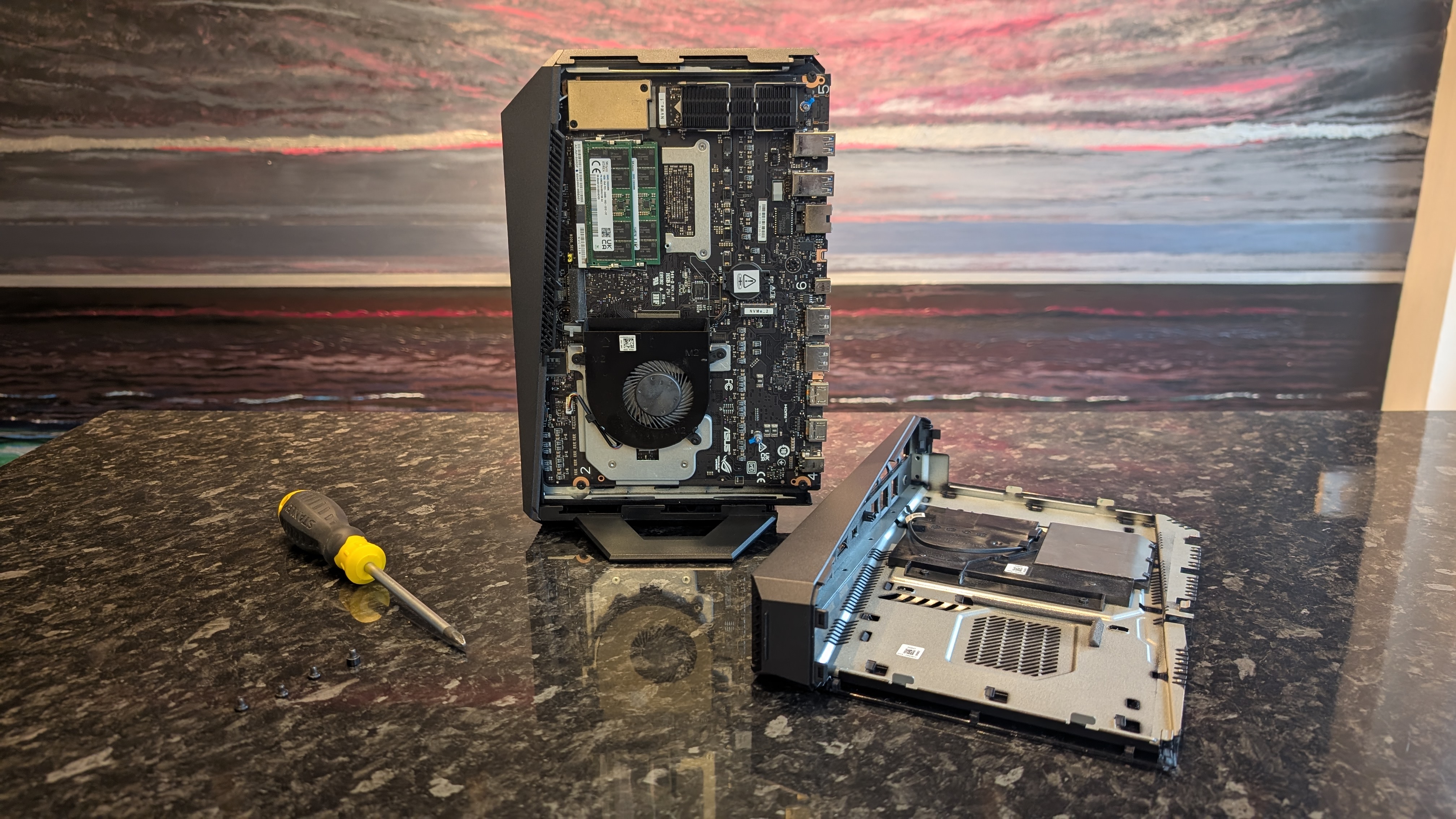
Upgrade options here are effectively limited to the RAM and SSD, and you’ll need to discard the old RAM if you want more, since there are only two DIMM slots and they’re both already occupied. There is, however, a spare M.2 slot for fitting a second SSD, should you want to expand your storage.
Really, this level of upgradability might be a slight step down from the more classic barebones NUCs Intel used to make, but it’s pretty par for the course as far as modern mini PCs go.
The case is also easy enough to open up for any upgrade work, which is nice to see; I’ve dealt with mini PC cases that seemed determined not to let me get at the goodies inside.
Thermal management is handled by multiple fans, with vents on both flat sides and the top. It’s quite effective at keeping the whole unit cool (even at the peak of my benchmarking process, the ROG NUC didn’t get particularly warm to the touch), although I would note that the fans can get rather loud when running resource-intensive games; if you’re planning to play in 4K, I’d recommend a headset or one of the best computer speakers.
Overall, I like the design; it’s a bit less visually busy than last year’s model, while still managing to fit in a good range of physical ports for connecting your devices. In addition to two HDMI and DisplayPort video outputs for connecting multiple monitors, you also get two Thunderbolt USB-C ports, six USB-A ports, an RJ-45 Ethernet slot, and the good ol’ 3.5mm headphone jack. As mini PCs go, this NUC has it all.
Asus ROG NUC (2025) review: Performance
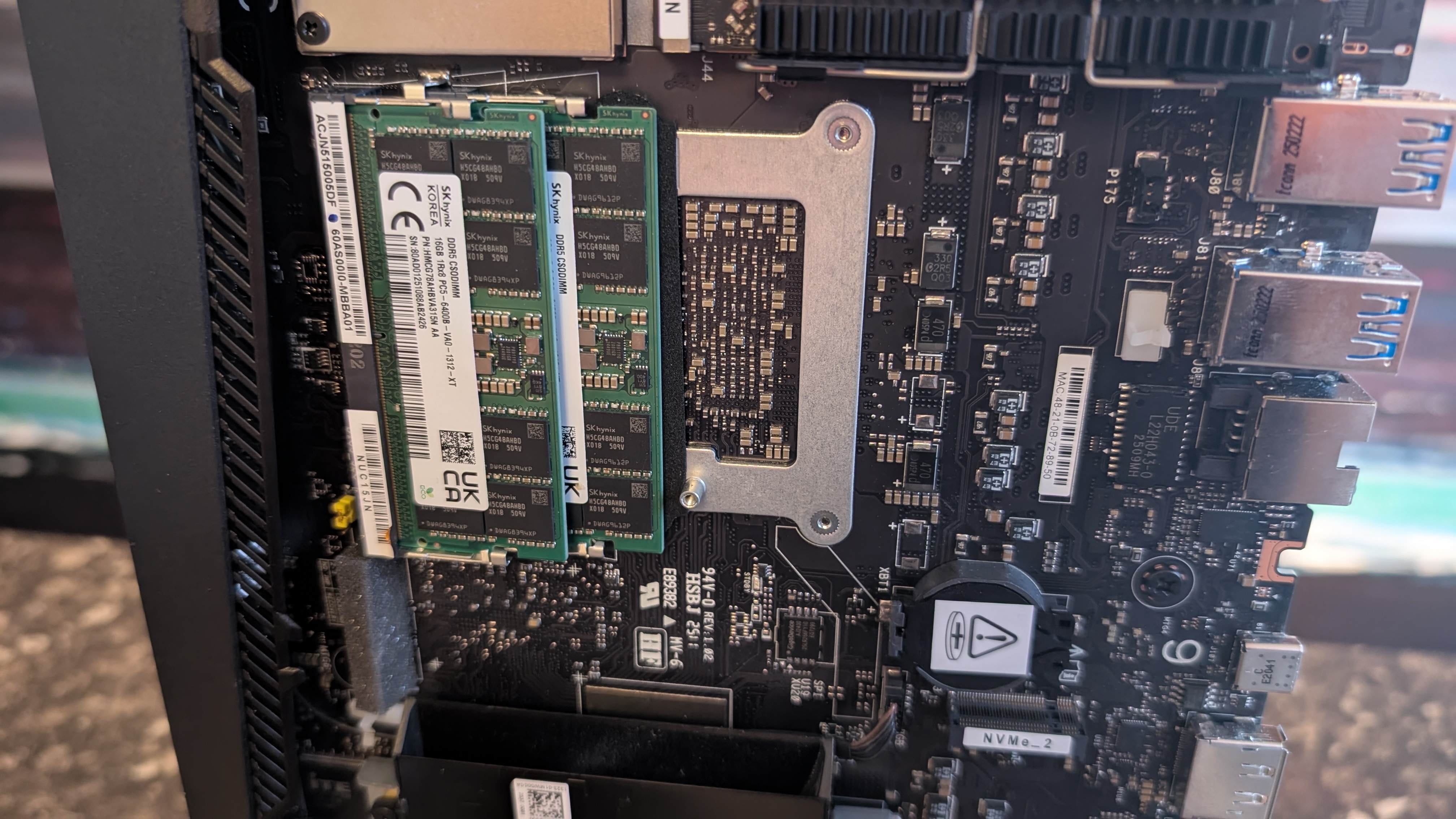
- Runs AAA games at high settings
- Strong performance in creative and AI workloads
- Fans do get rather noisy
Asus ROG NUC (2025) Benchmarks
Here’s how the Asus ROG NUC (2025) performed in our suite of benchmark tests:
Geekbench 6 (Multi Core): 19,683; (Single Core): 2,977
Geekbench AI (Single Precision): 28,951; (Half Precision): 50,926; (Quantized): 22,406
Cinebench R23 (Multi Core): 34,413; (Single Core): 2,188
Cinebench R24 (Multi Core): 2,011; (Single Core): 132
Crossmark Overall: 2,338
3DMark Fire Strike: 39,680; Steel Nomad: 5,309; Solar Bay: 106,741; Speed Way: 5,809; Port Royal: 14,233
BlackMagicDisk Read: 4,333MB/s; Write: 4,928MB/s
25GB Copy Test: 1,493MB/s
Shadow of the Tomb Raider (1080p, Medium): 225 FPS; (1080p, Highest): 219 FPS; (Balanced Upscaling, 1080p, Highest): 224 FPS
Total War: Warhammer III (1080p, Medium): 319 FPS; (1080p, Ultra): 176 FPS
Cyberpunk 2077 (1080p, Medium): 178 FPS; (1080p, Ultra): 148 FPS; (Balanced Upscaling, 1080p, Ultra): 157 FPS
Metro: Exodus (1080p, Medium): 239 FPS; (1080p, Extreme, No RT): 102 FPS; (Balanced Upscaling, 1080p, Extreme RT): 137 FPS
As you’d hope from a system with an Nvidia RTX 5080 – even the trimmed-down laptop version inside the ROG NUC – the gaming performance on offer here is undeniably strong.
Our standard benchmarking process uses games tested at 1080p (primarily without any upscaling tools, like Nvidia’s DLSS) to provide a realistic comparison point between systems. Needless to say, the ROG NUC absolutely blasted through these, offering stellar performance with triple-digit framerates in literally every test I ran.
Bump things up to 1440p and you’ll get similarly great performance, especially if you do turn on DLSS (no need for frame-generation here, honestly). At 4K, I found most games could still clear that prized 60fps mark, with only Cyberpunk 2077 and Metro Exodus requiring DLSS to maintain a stable framerate when turning on maximum ray-traced graphics. It’s worth bearing in mind that upscaling has more of an impact at higher resolutions; at 1080p, DLSS in Balanced mode only gained me an extra nine frames per second in Cyberpunk at the Ultra graphical preset, while at 4K that differential increased to a whopping 38.
I’d also like to address some of the concerns many gamers clearly have about DLSS (yes, I spend too much time on Reddit, I see those posts too). It literally works great. That’s all I have to say; the tech is four generations in at this point, and it’s been refined enough that I noticed no discernible difference in gameplay at 4K.
Frame-generation is a different story, of course – 4x Multi Frame Generation from Nvidia is frankly still wonky even if it does boost your FPS – but at this stage, we should all be using upscaling for playing games at any resolution above 1080p.
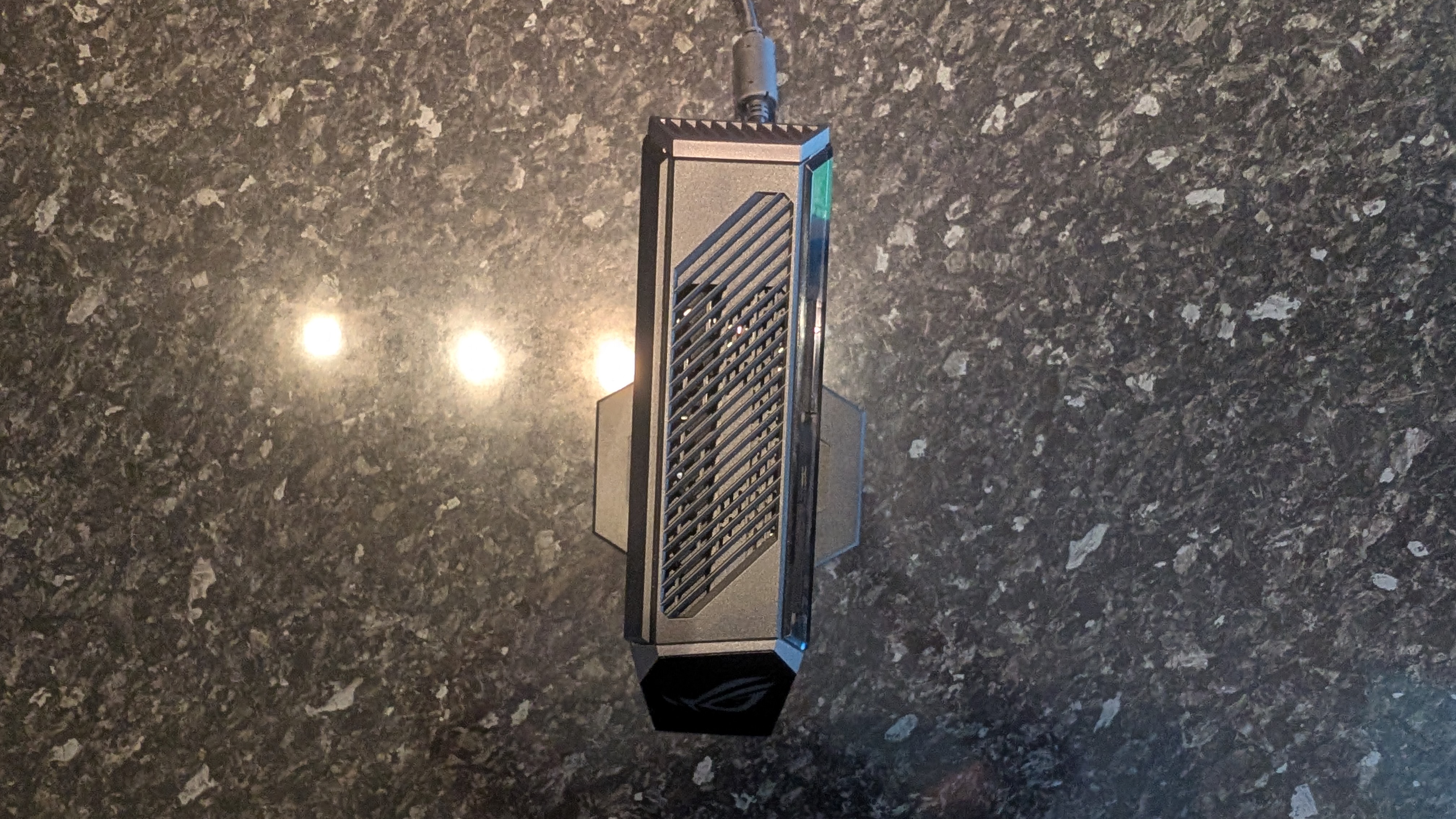
Outside of raw gaming performance, the ROG NUC performed admirably in synthetic tests across graphical, AI, and creative workloads.
The 3DMark graphic benchmark suite brought back results that were broadly what I anticipated: strong, but not quite on par with the ‘true’ desktop RTX 5080, so don’t buy this if you’re expecting a fully-fledged 5080 desktop experience squeezed into a compact chassis. At a fundamental level, this is more like a 5080 laptop in a desktop form factor.
Still, the results were good; the Intel Core Ultra 9 CPU also delivered solid numbers, with great performance in the Geekbench and Crossmark benchmarks, placing it comfortably on par with laptops equipped with the same processor. AI performance was also good, since the presence of a discrete GPU easily outweighs anything the Intel chip’s built-in NPU brings to the table.
Lastly, the SSD that comes with the ROG NUC is fast. With read and write speeds in excess of 4GB/s, the only thing that’ll constrain you in terms of file transfers is your internet connection. Games load up fast, and Windows 11 boots up faster.
Should I buy the Asus ROG NUC?
Attributes | Notes | Rating |
|---|---|---|
Value | Although it’s far from cheap, the pricing doesn’t place it ludicrously higher than similarly-specced systems, and the compact chassis is quite unique. | 4 / 5 |
Design | A fantastically compact design that somehow manages to cram in a ton of physical ports, the ROG NUC is one of the best-crafted mini PCs I’ve ever seen. | 5 / 5 |
Performance | Great gaming performance at any resolution, along with strong performance in creative and AI workloads – just bear in mind that this isn’t a full-fat desktop GPU. | 4.5 / 5 |
Total | The ROG NUC is, simply put, one of the best compact gaming PCs I’ve ever seen. I do wish it wasn’t quite so expensive, but Asus has really made something special here. | 4.5 / 5 |
Buy the Asus ROG NUC (2025) if…
Don’t buy it if…
Asus ROG NUC (2025) review: Also Consider
How I tested the Asus ROG NUC (2025)
- Tested for a week
- Used for work and general web browsing
- Replaced my usual desktop for gaming in the evenings
I tested the Asus ROG NUC for a week, including the weekend, during which time it took the place of my usual home office desktop system – a far chunkier PC. I used it daily for work and assorted other online activities; I’m currently rewatching The X Files, and I also used it to host a virtual TTRPG session.
I also spent plenty of time in my off hours using the ROG NUC for gaming, which is a regular hobby of mine. I mostly tested triple-A titles (in addition to our regular suite of game benchmarks), including Avowed and Remnant II, plus a cheeky bit of Stardew Valley, which was unsurprisingly not very taxing on the system.
I’ve been reviewing PC hardware for more than seven years and have been a PC gamer for more than twice that time, with so many laptop and desktop reviews under my belt at various publications that I sincerely can’t even count them. This was my first time reviewing a NUC unit since Intel sold the brand off to Asus, and needless to say, I’m very pleased with the work Asus has done.
- First reviewed: October 2025
- Read more about how we test

